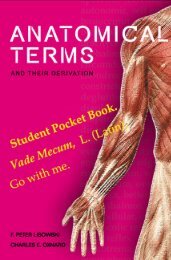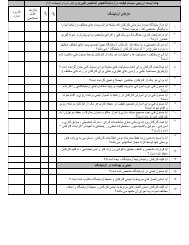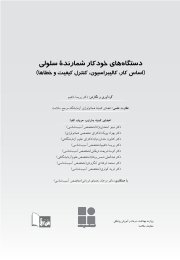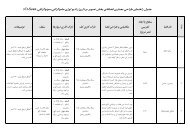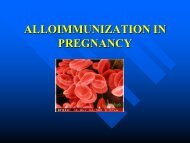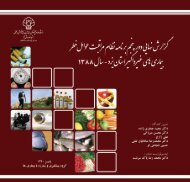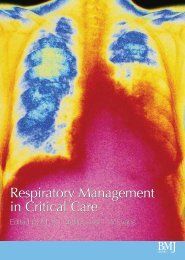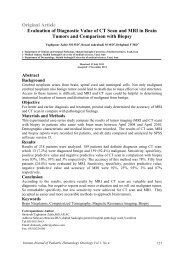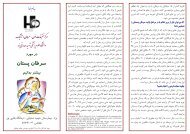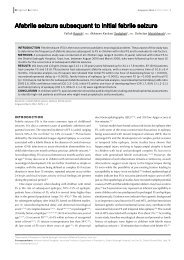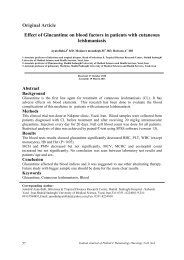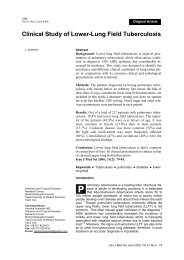Original Article Immunophenotyping of Leukemia in Children ...
Original Article Immunophenotyping of Leukemia in Children ...
Original Article Immunophenotyping of Leukemia in Children ...
- No tags were found...
You also want an ePaper? Increase the reach of your titles
YUMPU automatically turns print PDFs into web optimized ePapers that Google loves.
<strong>Orig<strong>in</strong>al</strong> <strong>Article</strong><strong>Immunophenotyp<strong>in</strong>g</strong> <strong>of</strong> <strong>Leukemia</strong> <strong>in</strong> <strong>Children</strong>, Gorgan, IranMirbehbahani NB MD 1 , Rashidbaghan A MSc 1 , Nodehi H MD 2 , Jahazi A MSc 3 , Behnampour N PhD 1 ,Jeihounian M MD 4 , Payab Z BSc 51- Hematology and Oncology Research Center, Golestan University <strong>of</strong> Medical Sciences, Gorgan-Iran.2- Islamic Azad University Gorgan Branch, Gorgan - Iran.3- Department <strong>of</strong> pediatrics, Taleghani Hospital, Gorgan- Iran.4- Baghiatallah Hospital, Baghiatallah University <strong>of</strong> Medical Sciences,Tehran- Iran.5- Department <strong>of</strong> oncology, Taleghani Hospital, Gorgan- Iran.Received: 28 June 2011Accepted: 23 October 2011AbstractBackground<strong>Leukemia</strong> is one <strong>of</strong> the most common tumors <strong>in</strong> children and it is divided up <strong>in</strong>to two ma<strong>in</strong>groups; acute and chronic leukemia. The acute leukemia is more prevalent than chronic <strong>in</strong>children. Generally acute type is <strong>in</strong>cluded acute lymphoid leukemia (ALL) and acute myeloidleukemia (AML). In this study, patients with leukemia who were admitted <strong>in</strong> Talghanihospital <strong>of</strong> Gorgan were exam<strong>in</strong>ed for immune markers.Materials and MethodsForty one patients (34 persons with ALL and 7 persons with AML) were exam<strong>in</strong>ed. Bonemarrow aspiration samples were obta<strong>in</strong>ed <strong>in</strong> tubes conta<strong>in</strong><strong>in</strong>g EDTA and were sent topathology center <strong>of</strong> Baghiatallah hospital, Tehran. <strong>Immunophenotyp<strong>in</strong>g</strong> was conducted byFlow cytometry and results were recorded <strong>in</strong> pr<strong>of</strong>iles <strong>of</strong> patients.ResultsThe mean age <strong>of</strong> ALL and AML patients was 5.64±3.43 and 7.45±5.68 years respectively. Itwas determ<strong>in</strong>ed that ALL risk <strong>in</strong> males is 1.086 times more than females. Mann-Whitney testdid not show significant difference between mean age <strong>of</strong> AML and ALL groups (p=0.5).Highest markers <strong>in</strong> ALL were CD19 (90.2%), CD10 (84.36%), I3 (HLA-DR) (70.58%), and<strong>in</strong> AML CD45 (81.8%), I3 (HLA-DR) (63.64%) and CD34 (54.5%).ConclusionThe prevalence <strong>of</strong> markers <strong>in</strong> ALL and AML patients is different, and some <strong>of</strong> them arecommon. These results could be used for differentiation <strong>of</strong> ALM from ALL. Further studywas recommended on bigger sample-size to achieve a def<strong>in</strong>ite conclusion.Keywords<strong>Leukemia</strong>, Child, <strong>Immunophenotyp<strong>in</strong>g</strong>Correspond<strong>in</strong>g AuthorAzam Rashidbaghan, expert <strong>of</strong> Hematology & Oncology Research Center, Golestan University <strong>of</strong> MedicalSciences, Gorgan-Iran.Email: rashidbaghan@yahoo.com.Fax: 01712328539Iranian Journal <strong>of</strong> Pediatric Hematology Oncology Vol 1. No 4.115
IntroductionOf all cancers <strong>in</strong> childhood, leukemias are one <strong>of</strong> the most important that are prevalent <strong>in</strong>children with the <strong>in</strong>cidence <strong>of</strong> 25-30% <strong>of</strong> all childhood cancers (1-3).Generally, leukemia is divided <strong>in</strong>to two categories, acute and chronic leukemia. Acuteleukemia is a heterogeneous group <strong>of</strong> neoplastic diseases and is categorized <strong>in</strong>to two ma<strong>in</strong>subgroups: acute lymphoid leukemia (ALL) and acute myeloid leukemia (AML) (4). ALL is aheterogeneous disease with abnormal proliferation and accumulation <strong>of</strong> immature lymphoidcells with<strong>in</strong> the bone marrow, peripheral blood and lymphoid tissues. ALL patients aresubdivided <strong>in</strong>to three morphological subsets <strong>in</strong>clud<strong>in</strong>g L1, L2 and L3 (5, 6). AML is anaggressive malignancy same as ALL and it is characterized by accumulation <strong>of</strong> immaturemyeloid progenitors <strong>in</strong> the bone marrow (7).<strong>Immunophenotyp<strong>in</strong>g</strong> is important not only <strong>in</strong> the classification and diagnosis <strong>of</strong> leukemia, butalso <strong>in</strong> the prediction and prognosis <strong>of</strong> these disorders (8). It makes complete morphological,cytochemical, cytogenetic and molecular studies for def<strong>in</strong><strong>in</strong>g diagnosis and prognosis. Thenvarious <strong>in</strong>vestigations have been conducted <strong>in</strong> this field.<strong>Immunophenotyp<strong>in</strong>g</strong> <strong>in</strong> patients with ALL <strong>in</strong> Ch<strong>in</strong>a beside cl<strong>in</strong>ical and cytogenetic featuresreveal the importance <strong>of</strong> <strong>Immunophenotyp<strong>in</strong>g</strong> <strong>in</strong> diagnosis and determ<strong>in</strong><strong>in</strong>g ALL type (9).<strong>Immunophenotyp<strong>in</strong>g</strong> CD antigens were studied <strong>in</strong> patients with acute leukemia <strong>in</strong> Iran (10).<strong>Immunophenotyp<strong>in</strong>g</strong> <strong>in</strong> children is so important, which present study for the first time wasdone among leukemic patients <strong>in</strong> Golestan.Materials and MethodsCasesThis was a descriptive and analytical study and 62 patients with leukemia were exam<strong>in</strong>eddur<strong>in</strong>g 2004-2009.Sample prepar<strong>in</strong>g and immunophenotype detectionPatients suspected to leukemia that were admitted <strong>in</strong> Talghani hospital <strong>of</strong> Gorgan werechecked by CBC test and then if their test were suspicious bone marrow aspiration would bedone. After confirm<strong>in</strong>g for leukemia, results <strong>of</strong> hematological, precl<strong>in</strong>ical and cl<strong>in</strong>ical studiesand morphological tests were recorded <strong>in</strong> patients’ pr<strong>of</strong>iles. Bone marrow aspiration sampleswere collected <strong>in</strong> tubes conta<strong>in</strong><strong>in</strong>g EDTA and sent to pathology center <strong>of</strong> Baghiatallahhospital <strong>of</strong> Tehran. The steps <strong>of</strong> <strong>Immunophenotyp<strong>in</strong>g</strong> were <strong>in</strong>cluded: 1) prepar<strong>in</strong>g 4 glassslides <strong>of</strong> bone marrow and 1 glass slide <strong>of</strong> peripheral blood; 2) sta<strong>in</strong><strong>in</strong>g one glass slide <strong>of</strong> eachsample by Wright method. Then sta<strong>in</strong>ed glass slides were checked by a pathologist.Accord<strong>in</strong>g to flow cytometry <strong>in</strong>struction, it is determ<strong>in</strong>ed which markers should becharacterized for each patient; 3) dilut<strong>in</strong>g samples accord<strong>in</strong>g to required marker (50µlsample+ 5 µl monoclonal antibody); 4) <strong>in</strong>cubation all <strong>of</strong> samples for 20 m<strong>in</strong>utes <strong>in</strong>refrigerator; 5) putt<strong>in</strong>g the samples <strong>in</strong> Q-Prep. In this device 3 solutions are added to samplesdur<strong>in</strong>g 35 seconds. Solutions <strong>in</strong>clude A (lyses buffer), B (buffer), C (fixative buffer); 6)f<strong>in</strong>ally all <strong>of</strong> sample tubes were transferred to flow cytometry device and then the results wererecorded.Statistical analysisStatistical analysis was performed by SPSS 18 and Mann-Whitney test, Leven test, relativerisk and Shopiro-Wilk test were used to compare the groups.116 Iranian Journal <strong>of</strong> Pediatric Hematology Oncology Vol 1. No 4.
ResultsAnalyzed data <strong>of</strong> 62 patients showed that 51 cases were ALL and the rema<strong>in</strong><strong>in</strong>g 7 with AML.There were 51 ALL patients (22 female and 29 male) and 11 AML patients (6 female and5male) (table 1). The ratio <strong>of</strong> male to female <strong>in</strong> all <strong>of</strong> patients was 1.21 to 1. This ratio <strong>in</strong> ALLpatients was 1.32 to 1 and <strong>in</strong> AML patients was 0.83 to 1. In all patients, the mean age was5.96± 3.92 years and the age range was 0.5-15. The mean age and the age range <strong>in</strong> ALL -group were 5.64± 3.43 and 0.5-13 respectively and about AML group these parameters were7.45± 5.68 and 0.75-15 respectively.Relative risk (RR) was used for verify<strong>in</strong>g effect <strong>of</strong> gender on leukemia type and wasdeterm<strong>in</strong>ed that ALL risk <strong>in</strong> males is 1.086 times more than females.R.R= 1.086 CI 95% (0.0.855-1.378)Table 1: Frequency distribution <strong>of</strong> leukemia type accord<strong>in</strong>g to genderALL AML TotalGender male count 29 5 34% with<strong>in</strong>gender85.3% 14.7% 100%female count 22 6 28% with<strong>in</strong> 78.6% 21.4% 100%genderTotal count 51 11 62% with<strong>in</strong>gender82.3% 17.7% 100%Mann-Whitney test was used for compar<strong>in</strong>g mean age <strong>in</strong> ALL and AML groups. Us<strong>in</strong>gShapiro-Wilk test, age distribution <strong>in</strong> ALL group was not normal (P=0.007), but <strong>in</strong> AMLgroup was normal (P=0.068). Also Leven test demonstrated non homogeneity <strong>of</strong> variances.Then nonparametric Mann-Whitney test was applied. It showed that there was no significantdifference between mean age <strong>of</strong> AML and ALL groups (p=0.5).The frequencies <strong>of</strong> AML and ALL morphological cell types were shown <strong>in</strong> table 2. L1 and L2were the most common types <strong>in</strong> ALL and L3 was not found among patients. Also there were2 AML patients with unknown leukemia morphological type.Table 2: Frequency distribution <strong>of</strong> leukemia morphological types<strong>Leukemia</strong> type AML ALLType M2 M3 M4 M7 unknown L1 L2Number 2 3 2 2 2 25 26Percent % 18.2 29 18.2 18.2 18.2 49 51Iranian Journal <strong>of</strong> Pediatric Hematology Oncology Vol 1. No 4.117
<strong>Immunophenotyp<strong>in</strong>g</strong> results are listed <strong>in</strong> Table 3. The most prevalent l<strong>in</strong>e <strong>in</strong> flow cytometrywas pre-B-cell, 29 patients (46.77%).Table 3: Frequency distribution <strong>of</strong> the most common markers accord<strong>in</strong>g to leukemia type and morphologicaltypeMarker <strong>Leukemia</strong> morphological type <strong>Leukemia</strong> type TotalCD19 number% <strong>in</strong> typeCD10 number% <strong>in</strong> typeHLA- numberDR % <strong>in</strong> typeCD34 number% <strong>in</strong> typeCD45 number% <strong>in</strong> typeL1 L2 M2 M3 M4 M7 UnknownAML22 24 1 1 0 0 088 92.3 50 33.3 0 0 020 23 0 0 0 0 080 88.5 0 0 0 0 017 19 2 2 1 0 268 73.1 100 66.7 50 0 1008 7 1 2 1 1 132 26.9 50 66.7 50 50 503 3 2 2 2 1 212 11.5 100 66.7 100 50 100ALL4690.24384.363670.581529.4611.8AML218.200763.64654.5981.848804371.74326.662133.871524.2The positive predictive value <strong>of</strong> CD19 for ALL is 95.8 % and negative p-value <strong>of</strong> it is 35.7%.Also positive p-value <strong>of</strong> CD10 for ALL is 100% and negative p-value <strong>of</strong> it is 42.1%. AboutHLA-DR, positive and negative p-value is 88% and 78.4 %, respectively.In this study, <strong>in</strong> addition to immunophenotyp<strong>in</strong>g, some factors such as hemoglob<strong>in</strong> value andcount <strong>of</strong> WBC were considered.Hemoglob<strong>in</strong> value was <strong>in</strong> 27 (43.5%) patients less than 7.5 mg/dl, <strong>in</strong> 25 (40.3%) between 7.5-10 mg/dl, and <strong>in</strong> 10 (16.1%) more than 10 mg/dl. In ALL patients, frequency was 20 (39.2%),25 (49%) and 6 (11.8%), respectively. In AML patients,<strong>in</strong> seven (63.6%) patients less than7.5 mg/dl and <strong>in</strong> 4 more than 10 mg/dl.Difference between AML and ALL was significant(P=0.007).The count <strong>of</strong> WBC <strong>in</strong> ALL was <strong>in</strong> 29 (58%) less than 2000, <strong>in</strong> 11 (22%) between 2000 to50000, and10 (20%) more than 50000. One patient has (2%) not report. The results <strong>in</strong> AMLpatients were 4 (36.4%), 3 (27.3%) and 4 (36.4%), respectively.Difference between AML andALL was not significant (P=0.379).The count <strong>of</strong> neutrophil was <strong>in</strong> 7 (14.3%) patients less than 500, <strong>in</strong> 8 (16.3%) between 500and 1000, <strong>in</strong> 7 (14.3%) between 1000 and 1500, <strong>in</strong> 27(55.1%) more than 1500, and 2 patients(3.92%) not reported. This count <strong>in</strong> AML patients, 2 (22.2%) was less than 500, 2 between1000 and 1500, 5 (55.6%) more than 1500, and 2 (18.18%) had not reported. Differencebetween AML and ALL was not significant (P=0.555).DiscussionIn the present discussion, HLA-DRwas 70.58 % <strong>in</strong> ALL patients and CD19 was the mostcommon marker <strong>in</strong> these patients. Philip Lanzkowsky has demonstrated that the mostcommon marker is HLA-DR, and CD19 is the second most important. The prevalence <strong>of</strong> L1is almost same as L2 <strong>in</strong> present study, but <strong>in</strong> Lanzkowsky book, L1 was 84% and L2 was 15%<strong>in</strong> ALL (11).Accord<strong>in</strong>g to other studies, it is possible to be a relationship between higher prevalence <strong>of</strong>HLA-DR and L1 and then connection between markers and morphology was considered hereand its results are presented as follow<strong>in</strong>g.In our <strong>in</strong>vestigation the prevalence <strong>of</strong> markers <strong>in</strong> L1, which was found <strong>in</strong> 25 patients and<strong>in</strong>volved 49% <strong>of</strong> all <strong>of</strong> ALL patients, was CD19, CD10 and I3 (HLA-DR) and also <strong>in</strong> L2,which <strong>in</strong>volved 51% rema<strong>in</strong><strong>in</strong>g <strong>of</strong> ALL patients, was as same as L1. Therefore the <strong>in</strong>cidence118 Iranian Journal <strong>of</strong> Pediatric Hematology Oncology Vol 1. No 4.
<strong>of</strong> markers <strong>in</strong> ALL patients was CD19 (90.2%), CD10 (84.36 %) and HLA-DR (70.58%) <strong>in</strong>general. It is noteworthy that <strong>in</strong> this <strong>in</strong>vestigation the majority <strong>of</strong> considered population wasALL patients. Based on frequency <strong>of</strong> HLA-DR and morphology type <strong>in</strong> our results, it may beconcluded that ALL prognosis is poor.Review<strong>in</strong>g other studies express that there is a few differences from ours <strong>in</strong> some studies andsome <strong>of</strong> them confirm our results (9, 12 and 13).Asvadi Kermani <strong>in</strong> northwestern, Tabriz <strong>of</strong> Iran (2002) showed the most frequent markers <strong>in</strong>ALL patients were CD7 (11-28%), CD2 (5-21%) and CD19 (3-14%). CD10 (1-5%) andCD20 (9%) were <strong>in</strong> the next positions (10). In this study there was not especial age range.Similarly, Haxia Tong et al (2010) studied on 113 patients with ALL <strong>in</strong> Ch<strong>in</strong>a. In this study,the most prevalent markers <strong>of</strong> B-cells <strong>in</strong>cluded CD19, CD10, CD22 and CD20. Frequency <strong>of</strong>these markers was 99%, 82.5%, 74.8% and 37.5% respectively (9).In general, CD19 was found to be common <strong>in</strong> this and other studies. Wenxiu et al, (2005)achieved those results <strong>in</strong> B-cell l<strong>in</strong>e. They studied on 81 ALL patients <strong>in</strong>clud<strong>in</strong>g 43 childrenand 38 adults. In this <strong>in</strong>vestigation CD5 and CD7 were the most common markers <strong>in</strong> T-celll<strong>in</strong>e (12). It should be noted that there are variety <strong>in</strong> these antigens <strong>in</strong> ALL patients <strong>of</strong>different regions. In research <strong>of</strong> Shen and colleges (2003) on 222 Ch<strong>in</strong>ese patients withleukemia, different results were obta<strong>in</strong>ed. In this population, 124 patients were ALL <strong>in</strong>clud<strong>in</strong>g94 patients with B- cell l<strong>in</strong>e and 30 people <strong>in</strong> T-cell l<strong>in</strong>e. In this study CD13 was the mostcommon antigen and after it, the most frequent markers were CD15 (11.3%), CD11b (6.5%)and CD33 (4.3%) (13).The frequency <strong>of</strong> the different antigens was various <strong>in</strong> various l<strong>in</strong>es <strong>of</strong> ALL. Study <strong>of</strong> Ramiaret al (2007) showed <strong>in</strong> Pre-B1, Pre-B2 and Pre-B <strong>of</strong> B-cell ALL, frequency <strong>of</strong> CD20 <strong>in</strong>creasesand CD10 decreases (14).In present study, the most common markers <strong>in</strong> AML patients were CD45, I3 (HLA-DR) andCD19 <strong>in</strong> M2, CD45, I3 (HLA-DR) and CD34 <strong>in</strong> M3, CD45, CD33, I3, CD34 AND CD64 <strong>in</strong>M4 and CD34, CD45, CD41, CD61 and CD7 <strong>in</strong> M7. CD45 (81.8%), I3 (HLA-DR) (63.64%)and CD34 (54.5%) were the most common antigens.The most markers <strong>in</strong> Asvadi Kermani research were CD13 (71%) and CD33 (74%) <strong>in</strong> M1,CD33 <strong>in</strong> M2 and CD13 <strong>in</strong> M3 (10).Tong HX et al, (2009) <strong>in</strong>vestigated the immunophenotypic subtype pr<strong>of</strong>iles <strong>of</strong> 192 patientswith AML. The results showed the CD33, CD13, myeloproxidase (MPO) and CD117 werethe most commonly expressed antigens <strong>in</strong> AML. CD117 expressed <strong>in</strong> 84.6% <strong>of</strong> AML-M3cases (15). Also Shen et al observed that the most common antigens <strong>in</strong> AML were CD7(12.8%), CD19 (6.4%) and CD2 (5.1%) (12). Sovariety <strong>of</strong> markers is observed <strong>in</strong> differentAML subgroups. Nevertheless, the presence <strong>of</strong> markers like CD34 is remarkable <strong>in</strong> this studysuch that frequency <strong>of</strong> CD34 is 65.1% and <strong>in</strong> our study is 54.5%.In our study, prevalence <strong>of</strong> some markers <strong>in</strong> ALL and AML patients were different from otherstudies and some <strong>of</strong> them were the same. These results could be used for differential diagnosis<strong>of</strong> AML from ALL. Present <strong>in</strong>vestigation was done on a small population <strong>of</strong> children, andfurther studies with bigger sample size will be needed to achieve a clear conclusion.AcknowledgmentThanks to colleagues <strong>in</strong> the oncology department <strong>of</strong> Gorgan Taleghani hospital. This articlehas no conflict <strong>of</strong> <strong>in</strong>terests.Iranian Journal <strong>of</strong> Pediatric Hematology Oncology Vol 1. No 4.119
References1. Pui CH. Childhood Ieukemias. N EngI J Med .1995; 332,1618-1630.2. Park<strong>in</strong> DM, Stiller CA, Draper GJ, Bieber CA. The <strong>in</strong>ternational <strong>in</strong>cidence <strong>of</strong> childhood cancer. Int J Cancer.1988 Oct 15;42(4):511-20.3. Pui CH, Schrappe M, Ribeiro RC, Niemeyer CM. Childhood and adolescent lymphoid and myeloid leukemia.Hematology Am Soc Hematol Educ Program. 2004:118-45.4. K<strong>in</strong>ney M, Lukens JN. Classification and differentiation <strong>of</strong> the acute leukemias. In: Richard Lee GR, BithellTC, Foerster J, Athens JW, Lukens J, et al, eds. W<strong>in</strong>trobe’s Cl<strong>in</strong>ical Hematology. Vol 2, 10th ed. Phil:Lipp<strong>in</strong>cott Williams & Wilk<strong>in</strong>s Co, 1998: 2209-2240.5. Bene MC. <strong>Immunophenotyp<strong>in</strong>g</strong> <strong>of</strong> acute leukemias. Immunol Lett 2005; 98, 9-21.6. Chan NP, Ma ES, Wan TS, Chan LC. The spectrum <strong>of</strong> acute lymphoblastic leukemia with mature B-cellphenotype. Leuk Res. 2003 Mar;27(3):231-4.7. Löwenberg B, Down<strong>in</strong>g JR, Burnett A. Acute myeloid leukemia. N Engl J Med 1999; 341,1051–1062.8. Jenn<strong>in</strong>gs CD, Foon KA. Recent advances <strong>in</strong> flow cytometry: application to thediagnosis <strong>of</strong> hematologicmalignancy. Blood. 1997 Oct 15;90(8):2863-92.9. Tong H, Zhang J, Lu C, Liu Z, Zheng Y. Immunophenotypic, cytogenetic andcl<strong>in</strong>ical features <strong>of</strong> 113 acutelymphoblastic leukaemia patients <strong>in</strong> Ch<strong>in</strong>a. Ann Acad Med S<strong>in</strong>gapore. 2010 Jan ;39(1):49-53.10. Asvadi Kermani I. <strong>Immunophenotyp<strong>in</strong>g</strong> <strong>of</strong> Acute <strong>Leukemia</strong> <strong>in</strong> Northwestern Iran. IJMS. 2002; 27(3):136-138.11. Philip Lanzkowsky. Manual <strong>of</strong> pediatric hematology and oncology.Fifth edition.Elsevier. 201112. Wenxiu.S and Yan. Ch. The characteristics <strong>of</strong> immunophenotype <strong>in</strong> acute lymphoblastic leukemia and itscl<strong>in</strong>ical significance. 2005; 4(6), 334-337.13. Shen HQ, Tang YM, Yang SL, Qian BQ, Song H, Shi SW, et al. [<strong>Immunophenotyp<strong>in</strong>g</strong> <strong>of</strong> 222 children withacute leukemia by multi-color flow cytometry]. Zhonghua ErKe Za Zhi. 2003 May;41(5):334-7.14. Ramyar A, Shafiei M, Rezaei N, Asgarian-Omran H, Esfahani SA, Moazzami K, et al. Cytologic phenotypes<strong>of</strong> B-cell acute lymphoblastic leukemia-a s<strong>in</strong>gle center study. Iran J Allergy Asthma Immunol.2009Jun;8(2):99-106.15. Tong HX, Wang HH, Zhang JH, Liu ZG, Zheng YC, Wang YX. [Immunophenotypes,cytogenetics andcl<strong>in</strong>ical features <strong>of</strong> 192 patients with acute myeloid leukemia]. Zhongguo Shi Yan Xue Ye Xue Za Zhi. 2009Oct;17(5):1174-8.120 Iranian Journal <strong>of</strong> Pediatric Hematology Oncology Vol 1. No 4.



